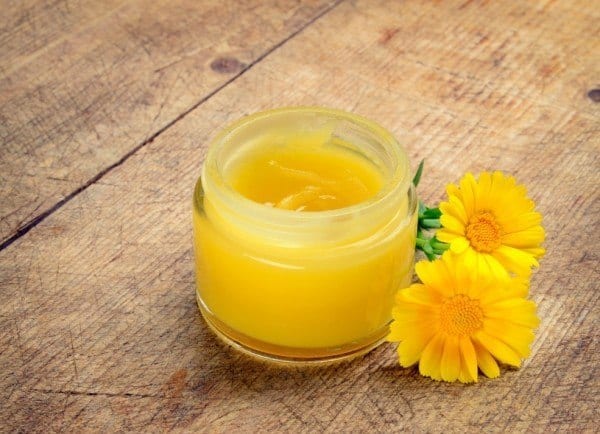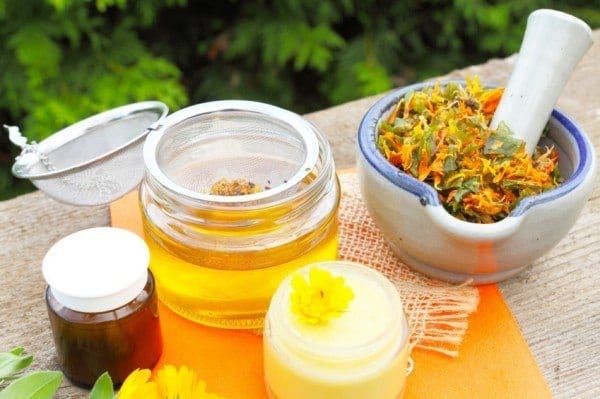
Commonly called the pot marigold, calendula has been used for centuries as a healing oil, tonic and so much more.
If you’re growing calendula in your backyard, but don’t know how to harness its fantastic powers, why not whip up a batch of nourishing calendula cream? Soothe away aches and pains, condition dry skin and even heal minor wounds with this miracle salve.
Homemade Calendula Cream
Making calendula cream is a two-step process that will result in a rich, smooth lotion that’s ideal for dry skin, cuts, bruises and more.
Ingredients
- 1 cup of a high quality carrier oil like olive oil, jojoba oil or grapeseed oil
- A bunch of dried calendula flowers
- 1 ounce of beeswax
- 1 cup of room temperature water
- 10 to 20 drops of essential oils of your choice (*see below for suggested oils) – Our recommended supplier of essential oils is always Plant Therapy for their quality and affordability. You can browse their selection here.
- A clean blender
- Clean mason jars or tins
Directions

- The first step in making calendula cream is to make an infused calendula oil. You can do this by allowing the bunch of dried flowers to steep in a cup of carrier oil, such as olive oil, in a sealed jar for several weeks. Alternatively, heat the oil and dried flowers in a slow cooker for 12 hours before allowing to cool, and continue to infuse, overnight.
- Strain the flowers out of the oil and transfer to a clean, airtight jar to store – or use immediately. You should be left with one cup of rich yellow calendula oil.
- Once your oil is ready to be used, place several cups of water in a pot and bring to the boil. Swirl two cups of this warmed water around the blender and leave to heat the glass in order to prevent the cream from sticking to the sides.
- Place a heat proof bowl on top of the pot to make a double boiler and turn the remaining water in the pot to a simmer.
- Pour one cup of the infused oil into the heat proof bowl, along with the beeswax. Stir gently until the beeswax has melted. Remove from the heat and stir in the essential oils.
- Discard the warm water from the blender, and pour in the melted oil and wax blend. Place the lid on the blender, leaving the filler cap off. Blend on a low speed while slowly pouring in one cup of room temperature water. Combine until the cream emulsifies, stopping to scrape down the sides of the blender if necessary.
- Pour the cream into the clean jars and allow to set before using. This all-natural, preservative free cream will keep for approximately one month when stored in the refrigerator.
*Suggested Essential Oils
For dry skin: Lavender, Neroli, Rosemary, Rose or Carrot Seed
For anti-aging: Geranium, Sandalwood, Frankincense, Lavender or Myrrh
For healing: Clove, Eucalyptus, Lavender, Tea Tree or Peppermint
All essential oils can be found and purchased from this page at Plant Therapy.
Why Use Calendula Cream?
Now that you have made your luscious healing cream, use it to battle a variety of skin and health conditions such as:
Dry Skin
Calendula has fantastic moisturizing properties and is a must for those with dry, flaky or cracked skin. Apply it once or twice a day as a body and face cream and you’ll soon notice a dramatic difference in the look and feel of your skin.
Acne
Calendula helps to reduce the bacterial load in the skin pores while also acting as both a cleanser and a toner. It has an astringent action that pulls in the skin pores, reducing chances of dust and dirt entering them.
Premature Aging
Calendula cream has natural restorative properties that can fight premature aging and thinning of the skin. This natural formulation can be used daily on the face, and is even gentle enough to apply around the eyes to prevent wrinkles and under-eye sagging.
Minor Wounds
Calendula’s mild antiseptic, anti-inflammatory and antimicrobial properties help speed up healing of wounds and minor cuts. It’s also a fantastic topical treatment for use on insect bites, rashes, sunburn, spider veins, varicose veins, leg ulcers and chilblains.
Animal studies indicate calendula may encourage healing by increasing blood flow and helping the body to make new tissue.
Muscle Pain
Massage sore muscles and aching joints with some calendula cream for pain relief and reduced swelling, thanks to its anti-inflammatory action.
Dermatitis and Eczema
Evidence suggests that calendula may help prevent dermatitis and skin inflammation – likely due to its ability to moisturize, rejuvenate and fight microbes and swelling.
It’s also frequently used in homeopathy to treat the inflammation caused by eczema.
Diaper Rash
This soothing water-based cream is ideal for treating diaper rash, particularly as it is antimicrobial and anti-inflammatory.
Similarly, calendula’s antifungal action is also effective at treating athlete’s foot, ringworm and jock itch.
Precautions
- Calendula is generally considered safe to use on the skin, although it’s best not to apply it to an open wound.
- Those who are allergic to plants in the daisy or aster family may experience an allergic reaction to calendula – usually a skin rash.
- Pregnant and breastfeeding women should generally avoid using calendula.
